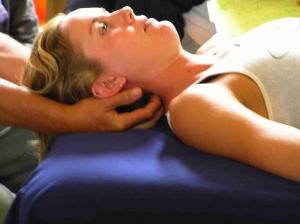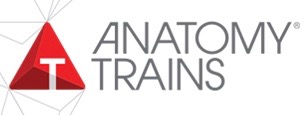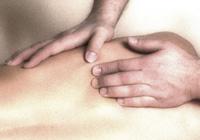ATSI: Anatomy Trains Structural Integration
- 1 90-Minute Session = $140
- 3 Sessions = $395
ATSI sessions can be used to resolve particular problems, as a “tonic” for your posture, movement, and what used to be called “carriage” – how you carry yourself through the world.
The ATSI approach is to free the binding and shortening in the connective tissues, what we refer to as the “fascial network”, and to re-educate the body in efficient and energy- sustaining (as opposed to energy-robbing) patterns.
This process happens over a series of sessions.
The ATSI process has 12 separate and progressive sessions, although the actual number best for you may be less.
To begin these sessions, your ATSI practitioner will talk over your history and help you set realistic goals for the process and examine your postural pattern/ movements.
Most ATSI sessions are done in underwear or a bathing suit. Your comfort is paramount, but we need to get directly to the tissues that are restricting the free flow of movement. Much of the session work is done on a treatment table, though some moves are done on a stool or even standing.
The practitioner will contact tissues and ask you to move, thus freeing old restrictions and encouraging the tissues back to a freer place called for by your body’s inherent design. You and your practitioner can work out how deep or how gentle you want the progression to be.
The sessions progress through the body:
The first sessions are generally more superficial, freeing the tissues on the front, back, and sides of the body and freeing the shoulders and arms from any binding to the trunk.
The middle four sessions address the “core” of you body, working into the central stabilization muscles closer to the spine.
The last four sessions integrate “core” and “sleeve” into your habitual movement (and address specific problems you bring to the table), leaving you with a lasting and progressive change that will echo throughout the rest of your life.
What makes ATSI different?
ATSI is a form of Structural Integration (SI). The other brands of SI – Rolfing®, GSI, Hellerwork, soma, Core, etc – are all good schools with talented practitioners.
Each school/brand has a distinctive “favour,” so the purpose of the next few paragraphs is to give a sense of the distinctive elements of ATSI.
ATSI is system-oriented, not symptom-oriented
ATSI work is applied gently and sensitively, with full client participation.
The ATSI series unfolds around a logical and coherent map of the myofasciae — the Anatomy Trains Myofascial Meridians.
- ATSI practitioners welcome and value other input.
- ATSI seeks client autonomy
1. Although many people come to ATSI and Structural Integration because of some kind of pain or restriction, the intent of this work — especially when undertaken as a series of sessions — is to get to the condition behind the immediate problem.
Many shoulder injuries, for instance, are caused by the lack of support from the rib cage. What’s the point of fixing the immediate problem if you don’t at the same time moderate the cause?
The ATSI series is designed to progressively build support, sturdiness, and balance throughout the structural system, so that there is a whole new ‘frame’ underlying your posture and movement, which can keep old injuries from coming back and help to prevent new ones from happening. Ida Rolf used to joke: “If your symptoms get better, that’s your tough luck”.
An ATSI practitioner may or may not address right away the area where you are having pain or restrictions – the roots often lie at some distance from the presenting problem. It may take several sessions or most of the series to get to the specifics of the problem, since we have to build up the supporting structure first. In this way, ATSI resembles classical acupuncture or homoeopathy or osteopathy – where the symptoms were secondary and building the ‘constitution’ is primary.
2. ATSI work is not imposed on the client.
The work should be on this side of the pain threshold, and the client and practitioner work out where the pressure and intensity level should be for maximum benefit. No good will come of ‘grinning and bearing it’ through an entire series. Occasionally, it is beneficial to ‘expose’ pain stored in the body, but ‘imposing pain’ is not a part of ATSI work.
Secondly, the client moves during the application of the manual therapy. If you are lying passively on the table for most of the session, you are not getting the best work you can get. ATSI follows Ida Rolf’s pithy dictum: “Put it where it belongs and call for movement.” Your movement produces several benefits: it lessens the sensation by spreading it out, it engages your proprioception (inner sensing) that helps integrate the work, and it also helps the practitioner stay on the right layer of fascia during the release.
Thirdly, your ATSI practitioner wants to hear about how the process is affecting you – physically, emotionally, in your exercise or other performance activities. Letting your practitioner know what’s up is very helpful in getting the best work for you.
3. The ATSI session series is built around a logical, coherent approach to the myofascial system.
The Anatomy Trains Myofascial Meridians provide a way to define the territory of each session, allowing the practitioner to be both confident that they are getting the proper territory, but also creative within each session to ensure that each individual client is getting the exact work that his or her unique pattern requires. There’s more information than you would ever want to know about the Anatomy Trains on this site.
4. The ATSI school, and ATSI practitioners, welcome other therapeutic inputs to your process.
ATSI is compatible with osteopathy, chiropractic, cranial work, and most forms of massage, yoga, and exercise.
We recognize that no way is the ‘one true way’ in manual and movement therapy, and we are always learning from other disciplines. Sometimes we absorb what we learn into our work, sometimes what we learn tells us when to refer to the other competent professionals available within the wide spectrum of healing.
5. The ATSI series is a project, with a beginning, middle, and an end.
The idea is to create the conditions where the client is independent and stable on their own, not to create a long-term dependency on the therapist or continued work. Of course people come back for more work, but not on a continuous basis. This work is best in short, intense periods of work, followed by longer periods of absorption. We want you, within a reasonable period of time, not to need us any more.
Shelly Stephenson
PMA®-CPT, BCSI
Schedule Online Here
Call 503–780–2621
info@shellystephenson.com
Body Mechanics
2512 SE 35th Place
Portland, OR 97202
503-379-9600


